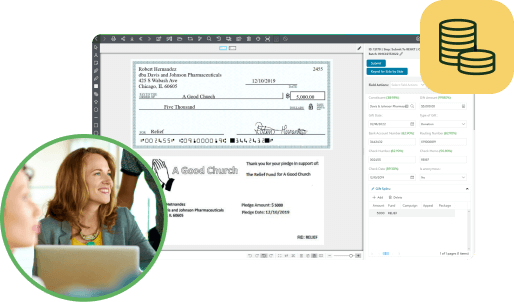
Janet Martin
Janet joined the PairSoft team upon its merger with Paramount Workplace, where she was also an integral part of the sales team for years. Janet resides in Michigan with her family.
View all posts by Janet MartinJanet Martin

The first difference is that nonprofits must reinvest all of their funds back into the organization itself, rather than focusing on how to make the greatest profit. The second big difference is that nonprofits use a system of fund accounting to manage their finances and create their budget so they can take into account any restrictions set on their revenue.
This second aspect is what we’ll focus on in this article: what are restricted funds, and how do they impact your nonprofit’s budget? Specifically, we’ll cover the following points:
Your nonprofit becomes more likely to run into restrictions as you grow and evolve. Understanding and having an effective system to handle restricted funds is key to minimizing their challenges in the future. Let’s dive in.
When donors, grantmakers, and other funders contribute to your organization, they have the right to add restrictions to their gifts. These restrictions provide the funders with a level of control over how your nonprofit spends the funds they contribute. They can therefore ensure their money is used to support the aspect of your cause that matters most to them.
So what is the functional difference between restricted and unrestricted funds for nonprofits?
The funder and the nonprofit must have a written agreement detailing how the funds will be used. For grantmakers, this is often written in the grant stipulations and the proposal. For donors, the agreement is approved by both parties after it has been drafted and revised.
All agreements a nonprofit enters into should be carefully considered in light of budgetary needs to ensure the organization has the funding necessary to cover all of its programs, overhead costs, and any other organizational expenses. The fundraising and accounting teams should be on the same page about what needs must be funded before entering into restriction conversations with funders.
As your nonprofit makes money, there are two main types of restrictions you may encounter: permanently and temporarily restricted funds.
Permanently restricted funds are set aside for specific interests and cannot be removed from that specific purpose. A common example of this type of restriction would be an endowment fund contributed by a donor.
Consider a nonprofit that receives $50,000 for an endowment fund where the interest earned on those funds will support a scholarship. That nonprofit will need to keep those funds dedicated for that purpose and only release the pre-designated amount for the scholarship each year. So, when they sit down to create a budget, those $50,000 will be earmarked and unable to be allocated elsewhere.
Even if this example nonprofit runs into financial difficulties, they cannot use these funds to support other programs or pay for overhead expenses. This is why it’s so important for nonprofits to allocate some of their unrestricted funds to a reserve fund in case of future economic turbulence.
Temporarily restricted funds are bound by either time or by a specific purpose. In this case, the nonprofit needs to use these funds for the specified purpose either until the project is completed or until the time limit for using the funds expires. These terms are agreed upon between the funder and the nonprofit.
Consider, for example, a temporarily restricted donation made for a capital campaign. After the project is completed, the ideal outcome would be for any leftover funds to be released from restrictions. However, this ideal scenario must be agreed upon before the funds are used.
In another example, a grantmaker might restrict funds so they must be used during a specific time period. When that time period is over, the nonprofit might be required to give the leftover funds back to the funder. In this situation, the nonprofit will be focused on how to make the best use of the funds before the time frame ends. They should also have this deadline marked prominently as a part of their grant management process. Having consistent processes in place to navigate budgets aids in both making the most out of the funds available and aiding with financial transparency.
If your organization only raised unrestricted funds, budgeting for the year would be much less complex. You could allocate all of your nonprofit’s funds exactly where you deemed them most important, whether that was to overhead expenses or to your latest programs.
However, nonprofits are likely to see some budgeting challenges associated with restrictions. For example, if your nonprofit solicits a $10,000 donation for a program that will cost $11,000, you’ve almost finished fundraising for that program! But if another unsolicited donor wanted to make a $5,000 donation to that same program, their gift would oversaturate the budget. Your nonprofit would then have two options:
However, there are also opportunities that accompany restricted funds. Restrictions often accompany the largest gifts made to a nonprofit. Therefore, when you enter into conversations with a major donor, you can bring up the restrictions on your own and direct them to the greatest need at your organization. Bloomerang’s major gift guide points out that the language around your solicitations for these major gifts should be as specific as possible, explaining why the funds are important and what their impact will be.
An open line of communication between your accounting team and your fundraising department will ensure that your fundraising plan aligns with your greatest budgetary needs. Set yourself up for fundraising success by ensuring these two important teams communicate regularly and openly about your nonprofit’s priorities.
Restrictions make nonprofit accounting unique from for-profit financial management. You should always understand which of your assets are restricted, what they’re restricted for, and how you can build your budget around them.
When you go back to report your finances on your other accounting materials, such as your statement of activities or statement of functional expense, you can make sure you were accountable to your various supporters and used their funds according to your agreement.
Is your nonprofit falling behind on more important strategizing due to manual tasks? PairSoft’s natively integrated fundraising solutions have helped leading organizations strengthen their processes to actually focus on fundraising. Get a demo today.
If not, talk to an expert today to see how our integrated gift and donor workflows can complement your Blackbaud setup.


Many organizations start with manual receipt handling, fragmented card feeds and slow AP processes. Implement AI agents to auto-capture receipts, route approvals, enable punch-out buys and post to the ERP.
Result: faster batching, fewer errors and cost savings. “This saves us hours every month.”
Many organizations face slow, paper-heavy AP and fragmented procurement that waste time and inflate costs. AI Agents can automate approvals, PO matching and record sync to improve speed, accuracy and control. Client quote: “It freed up hours and made our process reliable.”
Operational drag and rising costs slow growth: teams waste time on manual tasks, misaligned priorities and opaque processes. AI Agents help automate routine work and coordinate actions across teams. “We’ve lost time to repeats and handoffs,” says a typical client.
Companies struggle with manual procurement, fragmented approvals, and costly integrations that slow growth and obscure spend. Our AI Agents streamline requisitions, POs, and invoice matching to cut manual work and improve visibility. “We were wasting time and missing insights,” says a client.

Many teams start with fragmented PO/AP systems, manual matching and delayed financial reporting. Deploying AI agents to automate PO checks, real-time encumbrance tracking and invoice matching reduces processing time and errors, delivering live budgets and faster closes. “Finally, we can see current balances and approve instantly.”
Many companies juggle growing invoice volumes and legacy systems. They struggle with manual processes, compliance gaps and limited headcount. Our AI Agents automate integrations, enforce rules and surface exceptions. The typical outcome: faster closes and measurable ROI. “We stopped chasing invoices.”